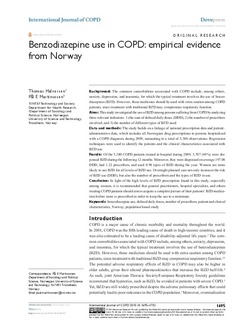| dc.description.abstract | Background: The common comorbidities associated with COPD include, among others, anxiety, depression, and insomnia, for which the typical treatment involves the use of benzodiazepines (BZD). However, these medicines should be used with extra caution among COPD patients, since treatment with traditional BZD may compromise respiratory function.
Aims: This study investigated the use of BZD among persons suffering from COPD by analyzing three relevant indicators: 1) the sum of defined daily doses (DDD); 2) the number of prescribers involved; and 3) the number of different types of BZD used.
Data and methods: The study builds on a linkage of national prescription data and patient–administrative data, which includes all Norwegian drug prescriptions to persons hospitalized with a COPD diagnosis during 2009, amounting to a total of 5,380 observations. Regression techniques were used to identify the patients and the clinical characteristics associated with BZD use.
Results: Of the 5,380 COPD patients treated in hospital during 2009, 3,707 (69%) were dispensed BZD during the following 12 months. Moreover, they were dispensed on average 197.08 DDD, had 1.22 prescribers, and used 0.98 types of BZD during the year. Women are more likely to use BZD for all levels of BZD use. Overnight planned care not only increases the risk of BZD use (DDD), but also the number of prescribers and the types of BZD in use.
Conclusion: In light of the high levels of BZD prescription found in this study, especially among women, it is recommended that general practitioners, hospital specialists, and others treating COPD patients should aim to acquire a complete picture of their patients’ BZD medication before more is prescribed in order to keep the use to a minimum.
Keywords: benzodiazepine use, defined daily doses, number of prescribers, patient and clinical characteristics, Norway, population based study | nb_NO |
